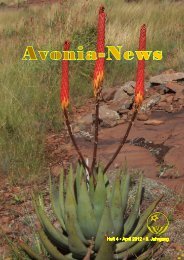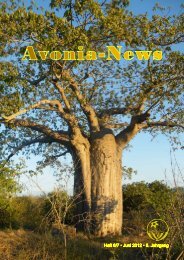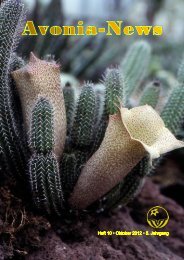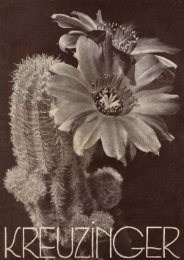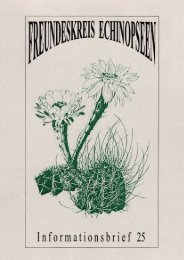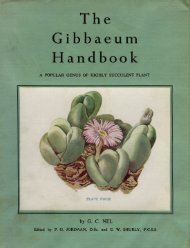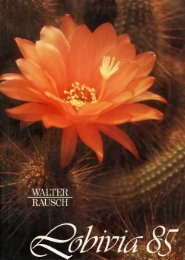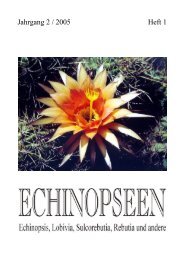VOLUME 14 :: January—October, 1952 Illustrations shown in ...
VOLUME 14 :: January—October, 1952 Illustrations shown in ...
VOLUME 14 :: January—October, 1952 Illustrations shown in ...
You also want an ePaper? Increase the reach of your titles
YUMPU automatically turns print PDFs into web optimized ePapers that Google loves.
30 THE CACTUS AND SUCCULENT April, <strong>1952</strong><br />
THE SCIENTIFIC APPROACH TO SUCCULENTS<br />
The Literature on Succulents<br />
By GORDON D. ROWLEY<br />
INSTALMENT SIX<br />
" Of mak<strong>in</strong>g many books there is no end ;<br />
And much study is a wear<strong>in</strong>ess of the flesh."<br />
—Ecclesiastes 12 : xii.<br />
In my first flush of schoolboy enthusiasm for succulents, the names of Higg<strong>in</strong>s and Jacobsen, Borg and Haselton<br />
filled the whole horizon. University days broadened the outlook, and with a list of 100 titles <strong>in</strong> 1945 I imag<strong>in</strong>ed<br />
little rema<strong>in</strong>ed to be read. It was Mr. R. K. Byrd who really opened my eyes to the vastness of succulent literature.<br />
With the equivalent of 40 feet of bookshelves packed to overflow<strong>in</strong>g, he still had not exhausted the possibilities.<br />
Today, with a select <strong>in</strong>dex of over 2,000 titles, I f<strong>in</strong>d references cont<strong>in</strong>ue to come <strong>in</strong> too fast to handle comfortably.<br />
Consider first the scope of the subject. About two to three percent, of the world's flower<strong>in</strong>g plants, members<br />
of two dozen families—are eligible for <strong>in</strong>clusion <strong>in</strong> succulent collections. They live <strong>in</strong> unexpected places ; their<br />
anatomy is extraord<strong>in</strong>ary, their metabolism unique. No conscientious ecologist, morphologist or physiologist<br />
can therefore afford to ignore them. Wild or naturalised, succulents occur throughout the world, except towards<br />
the poles, and accounts of them are hence ever likely to turn up <strong>in</strong> local floras, natural history society journals and<br />
garden<strong>in</strong>g weeklies. And to all this is added the spotlight of popular favour ; the cactus is the fashionable <strong>in</strong>door<br />
plant of the austere n<strong>in</strong>eteen-fifties, and nurserymen are not slow to keep the fashion alive. If you need further<br />
proof of the amount written on succulents, scan the back issues of " Amateur Garden<strong>in</strong>g " or the 200 odd volumes<br />
of the " Gardener's Chronicle," or run your eye through the collective <strong>in</strong>dices of the R.H.S. Journal or Curtis's<br />
"Botanical Magaz<strong>in</strong>e." I try to keep check of the various society periodicals deal<strong>in</strong>g with Cact^es, Kakteen, Cactussen,<br />
Kakt6er, Cactaceas and Cacti <strong>in</strong> a dozen other less familiar languages : goodness knows how many there are<br />
beyond the thirty known to me.<br />
Book Collect<strong>in</strong>g<br />
As soon as one graduates beyond the four-book-stage <strong>in</strong> succulents, one has to face the heart-aches of<br />
book-buy<strong>in</strong>g <strong>in</strong> mercenary, dollar-starved England, where this type of specialist hobby provides a playground for<br />
the collector maniac who thrives on limited editions and curiosa. I have seen priceless books on succulents hoarded<br />
for years as collector's pieces, often with the pages uncut, or <strong>in</strong> languages the proud owner would never admit he<br />
cannot read. How often has one wished that rare books, like Crassulas, would multiply ad lib by cutt<strong>in</strong>gs !<br />
At this po<strong>in</strong>t one might reasonably ask : "Why bother with these old books ? Are not the modern ones<br />
far better ? " The answer is yes, <strong>in</strong> many ways—certa<strong>in</strong>ly <strong>in</strong> descriptive detail, presentation and general grasp of<br />
the subject. But the older books exhale a charm of their own, particularly when they have hand-coloured<br />
illustrations, the product of a long-forgotten age of cheap, skilled labour. Also they are valued for their first<br />
descriptions of new plants, which determ<strong>in</strong>e future ideas on the <strong>in</strong>terpretation of species.<br />
Types of Book<br />
A bibliography on succulents covers everyth<strong>in</strong>g from the smallest pamphlet to encyclopaedias ; from gardeners'<br />
pocket books to impressive monographs, " some ... to be tasted, others to be swallowed, and some few to be<br />
chewed and digested." There are highlights and shadows ; mysteries, curiosa and jokes. There are the purely<br />
"arty" books like "Les Fleurs Plantes Grasses" (Davids and De Montherlant), and the solidly academic : "Notes<br />
on Mesembrianthemum Part II " (L. Bolus) with descriptions of 782 new species <strong>in</strong> Lat<strong>in</strong>. There is the strictly<br />
factual title, like " The Genus Sedum L," and the sickly sensational : " Great Scott—the Thrill of Cactus Grow<strong>in</strong>g."<br />
There is the <strong>in</strong>tentionally humorous " What K<strong>in</strong>d'a Cactus Izzat ? "a classic by Reg Mann<strong>in</strong>g, and the un<strong>in</strong>tentionally<br />
humorous, as Haage's first attempt to render his " Kakteen Zimmerkultur " <strong>in</strong> English. There is Loudon's<br />
amaz<strong>in</strong>g " Encyclopaedia of Plants," the ultimate <strong>in</strong> compressed <strong>in</strong>formation, and a book like Rouhier's " Le<br />
Peyotl," with 372 pages devoted to one plant, Lophophora williamsii. There is even one pornographic item! And<br />
1 wonder how many beg<strong>in</strong>ners have ordered Ethel Mann<strong>in</strong>'s popular novel " Cactus " <strong>in</strong> the impression that it<br />
would help them to name their Mammillarias ?<br />
First prize for lavishness must go, I th<strong>in</strong>k, to De Candolle's opulent folios of " Plantarum Succulentarum<br />
Historia " (1799-?!837), with up to 187 full page colour plates by Redoute, best known of all plant illustrators.




